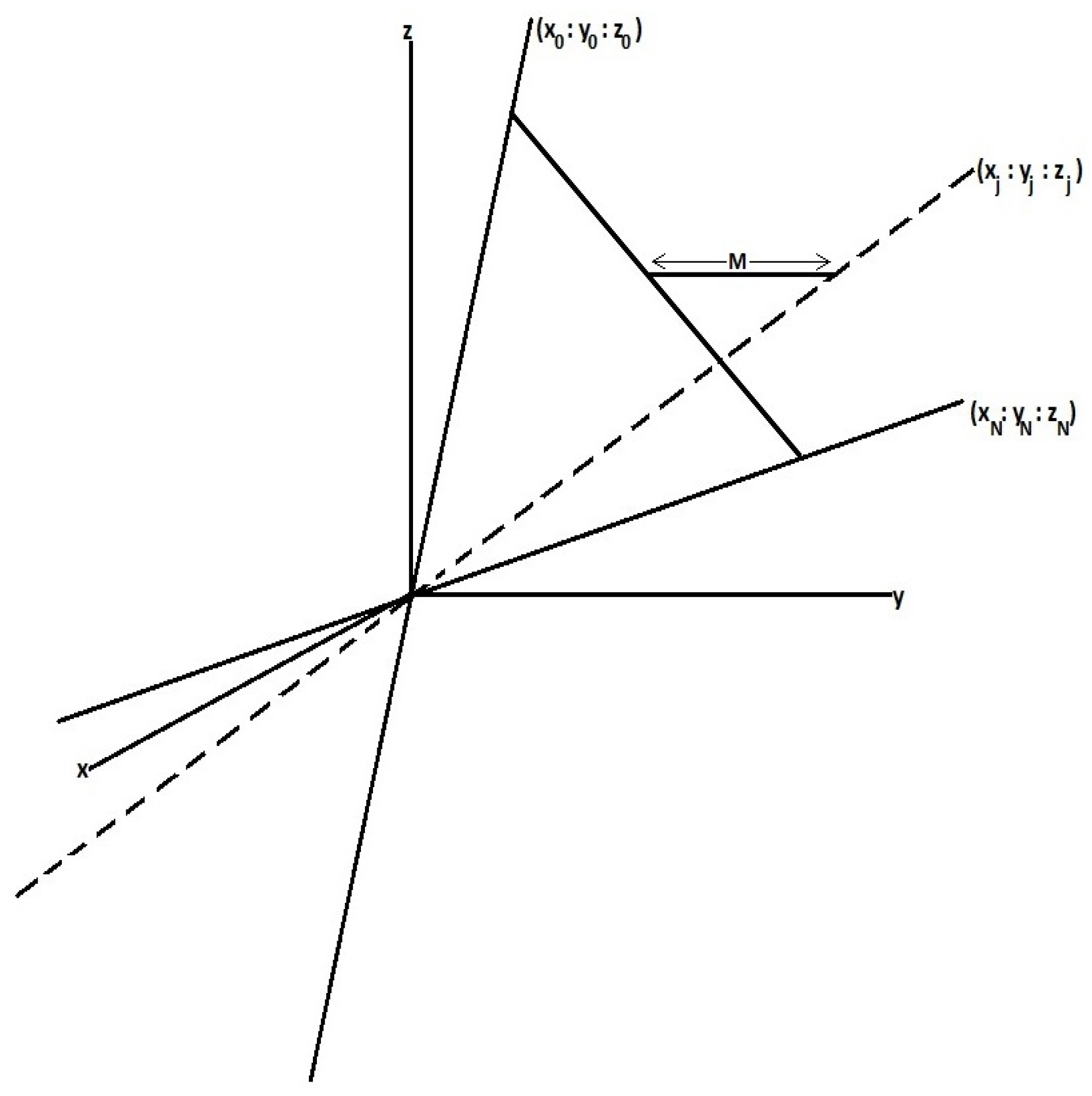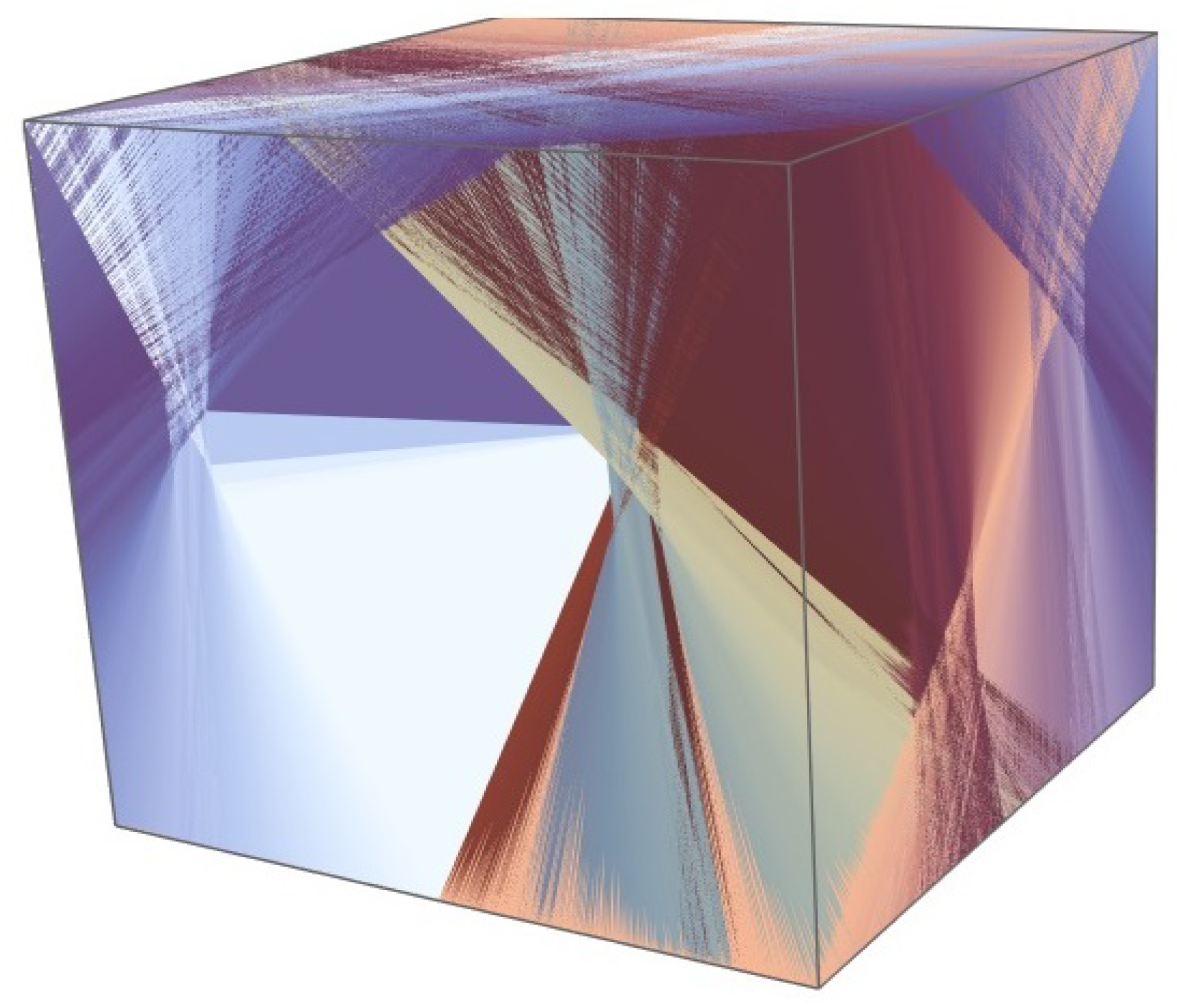1. Introduction
Fractals are those geometric objects on abstract spaces that own some kind of self-similarity. The best-known example of the fractal set is called the Mandelbrot set, named after the mathematician Benoit Mandelbrot who coined the term fractal [
1]. In geometry, one of the most important methods to construct fractals is based on iterated function systems (IFSs). Based on some historical precedents, Hutchinson [
2] introduced IFSs to generate self-similar sets. Barnsley [
3] used another tool to construct fractals as the graphs of self-referential functions, known as fractal interpolation functions (FIFs). Most of the authors studied fractal interpolation on the Euclidean spaces [
4,
5,
6,
7,
8]. Recently, Barnsley et al. [
9], studied IFSs on the real projective plane. Hossain et al. [
10] introduced the real projective fractal interpolation function ( RPFIF) by considering a real projective iterated function system (RPIFS) on the projective plane.
In mathematics, given a Euclidean space
, the real projective space associated with
is the collection of all one-dimensional subspaces or (vector) lines in
, and is denoted by
. One can identify
as the quotient of the set
of non-zero vectors by the equivalence relation
if and only if
for some
(non-zero reals). Now, for
, we denote
as the equivalence class containing
x. Thus, there exists a canonical map
that associates each non-zero vector
with the element
. The points
such that
is referred to as homogeneous coordinates of an element
. If
have the homogeneous coordinates
and
, respectively, and
, then we say that
p is orthogonal to
q, and write
. A hyperplane in
is a set of the form
for some
. A set
is said to avoid a hyperplane if there exists a hyperplane
such that
. A line in the real projective space is the set of equivalence classes of points in a two-dimensional subspace of
. Here, we recall a few notations and results from one of our earlier works [
10]. Consider the hyperplane
where
and the space
in particular, defining two operations ⊕ and ⊙ as follows. For all
and for all
,
and
forms a vector space over
with respect to the operations ⊕ and ⊙. Use the notation ⊖ to indicate the difference between two elements in
. That is, if
, then
. So, each element
in
can be expressed as a sum of two of its elements, namely
and
. That is,
. Let
and
. Then,
can be expressed as
Define a norm on
, called a projective norm, as follows:
for all
. The projective norm induces a metric which is denoted by
. The space
is complete with respect to this norm. For
, denote that
, if and only if
, and
, if and only if
. Similarly for
, define
, if and only if
, and
, if and only if
.
Definition 1 (Projective intervals on
and
[
10]).
Let be such that . Then, the projective interval on is denoted by and defined bySimilarly, the projective interval on , is denoted by and defined by Definition 2 (Projective rectangle [
10]).
Let and be such that and . Then, the projective rectangle on is defined by Let
If
, define
. Since
is compact,
is well defined. For more details, interested readers may consult [
10].
Let
and
be a dataset in
such that
for
. Let
and
for
. For
, consider the transformations
given by
such that
where
. Then
’s are contraction maps with respect to the metric
. For
, consider the continuous maps
given by
such that
where
. If
, then
’s are contractive with respect to the second variable. Now, for
, define the functions
by
The transformation
s are known as projective transformations, (as can be seen in [
9,
10]).
Theorem 1 ([
10]).
The RPIFS has a unique attractor, which is the graph of a continuous function from to . This function is known as RPFIF on a real projective plane.
The fractal dimension, which is in the heart of the fractal geometry, is usually considered in connection with real world data. It measures the complexity of a geometric shape in the space and it also provides an objective procedure in order to numerically compare the fractal sets. It may also be seen as a measure of the space-filling capacity of a pattern. The fractal dimension may not be an integer. In the literature, the concept of several dimensions of the fractal sets with respect to the Euclidean distance on the plane was largely treated (as can be seen, for instance, in [
5,
6,
11,
12,
13,
14,
15,
16,
17,
18]).
In this article, on the basis of these concepts, we estimate the fractal dimension of the graph of an RPFIF. As the graph of an RPFIF can be viewed as a subset of the real projective plane as well as a subset of , the dimensions are estimated in both cases. The topological dimension of the projective plane is two and the dimension of is three. In this article, we prove that, if D is the dimension of the graph of RPFIF in , then is the dimension of it in .
One of the interesting features of the projective geometry is that of duality. In projective geometry, the dual of a point is a line and the dual of a line is a point. Dual space is the collection of all the hyperplanes of a projective space. It is used in many branches of mathematics, such as tensor analysis with the finite dimensional spaces, measure distribution, and Hilbert spaces [
19]. At the end of this article, an open problem concerning the dual RPFIF is posed.
3. Dual of the RPFIF
Recall the real projective metric
on
defined in
Section 1. The hyperplane orthogonal to
is expressed as
Definition 4. Let denote the set of all hyperplanes of , or equivalently, . Then, the space is said to be the dual space of . The addition on is induced from the addition on . That is . The dual space is endowed with a metric defined byThe map defined by is called the duality map. Remark 1. The duality map Q is an isometry between the metric spaces and . Hence, is a complete metric space.
Since Q is continuous, it can be extended to a map from to
in the usual way. That is, for
,
Let
and
. Now, for
,
x can be written as
, where
and
. Then, from the definition of the addition on
,
. Thus,
can be expressed as
Here, we use the same notion ⊕ for the addition. Now, for a given dataset
on
, we can extend
and
, which are defined in (
5) and (
6), respectively, as follows
such that
and
, where
and
. Define
such that
Definition 5. The collection is said to be a dual RPIFS.
Figure 3 represents the attractor of a dual RPIFS corresponding to the RPIFS given in [
10] (Section 4, Example 4.0.1, with scaling factor
).
Conjecture 1. If G is the graph of the RPFIF corresponding to the RPIFS given by (8), then there exists an attractor corresponding to the dual RPIFS such that is also the graph of a self-referential function. Moreover, . 








